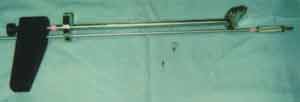Bbc Radio special covering hips and history:
Listen while you read.
http://www.bbc.co.uk/radio4/factual/pip/k7lk5/
locally cached archive copy of above in mp3
The Swedish Register shows the cementless failure rate more than twice worse than cemented. The long term results of cement systems are the best data and results are very good. The data available on the internet is referenced below.
simplicity and cement. The results are good the data collection is good, why are people parroting the idea that glued hip replacement is bad? Where is the proof? All the data I have seen shows the glue to be as good as or better than glueless implants.
The cement was long used in dentistry before application in Hip Implants.
Hip fracures used to be a leading cause of death because of complications
from bed rest. Strokes or Pnumonia for example. Charnley perfected the cemented
hip replacement to get people out of bed and wieght bearing as soon as possible
to save lives. The cement-less hip replacments delay full and painless wieght
bearing. What data addresses the mortality of delayed wieght bearing, or
increased short term revisions in cementless implants?
The Charley femoral implant came in one size and one piece. When Dr. Charnley
was asked why he did not make more sizes, He said more sizes would multiply
the chances of the surgery going wrong. Where is the data to show that newer
hip systems are better than the one piece designs?
Glue makes every prosthesis an instant custom fit with infinite interlocking
buffered distributed contact points as compared to only three highly stressed
direct points of contact of the wedged in cementless prostheses. Persistant
theigh pain is a known complication of cemetless prosthesis. Large numbers
of sizes of expensive prothesis, supply and obselence issues, product recalls
and high costs.
Metal is has a long history of loosening and rejection over time in bone.
( Perhaps a 40% rejection rate) This has been observed in Metal Plates and
screws, and resulted in the practice of removing them.
(ed. a one size fits all cemented prothesis, whose manufacture is simple,
whose patents are long expired, for which there is sales competition, is
not going to provide the profits of new prothesis which requires inventories
of many sizes, elaborate matched tools, sophisticated manufacturing procedures
and patents which inhibit competition. For the Doctors there is the need
to write papers in academia, and in private practice there is the competition
to seem more "modern". FXG)
Where do you buy one piece cemented prothesis? Stem and Cup in the US? or
anywhere? is it time to start
manufacturing the original Charneley Cobra Style again?
Here are some issues of interest on installing cemented hips
Use single
Use Mini Incision (with inserting tool)

Entry to Preserve Capsule Ligaments and musculature
Preserve Femur length and bone
Bias Neck/Socket axis to avoid dislocation
Extend implant to keep located by taught preserved ligamenture
Rapid Recovery,Discharge,Exercises
References
A very good website, (much better in totality than this one) about total hips
Good comparison of cemented and cementlesss:
http://www.totaljoints.info/cemented_and_cementless_thr.htm
The Swedish Register comparison of Cemented and others is contained on page
9. The ceramics are new and suspect, one model is under recall.
http://www.totaljoints.info/ceramic_total_hips.htm
Other links and References
Review of Cemented as the "Gold Standard"
http://www.maitrise-orthop.com/corpusmaitri/orthopaedic/mo83_delaunay/delaunay_us.shtml
(cached copy of above)
30 year Cemented results
http://www.jbjs.org/abstracts/maoa03/maoa_abs1-8.pdf
(cached copy of above)
25 year Cemented results
http://www.jbjs.org/Comments/pdf/JBJA085061066.pdf
(cached copy of above)
This is a 4 year study that says no difference between cement and cementless
http://www.corronline.com/pt/re/corr/abstract.00003086-199604000-00044.htm;jsessionid=EEX9JXji1pThHM02lo2WFAonSw5P6gUhAAY1nrYVDcIWlwFAVVJ2!-469394890!-949856145!9001!-1
Radiographic review and references showing failures of all kinds.
http://www.gentili.net/thr/loosenin.htm
http://www.gentili.net/thr/types.htm
Information on Clean Room Surgery that was originally part of Charnelys procedure,
its history and some ideas on inexpensivly keeping the option rapidly available
in the design of new surgical rooms. Epidemic or Antibiotic resistance could
make this extra precaution worth the trouble again.